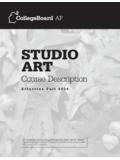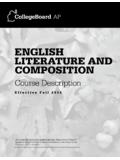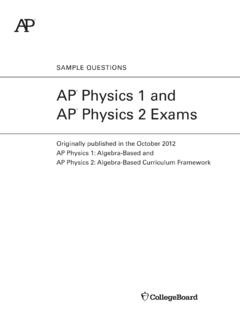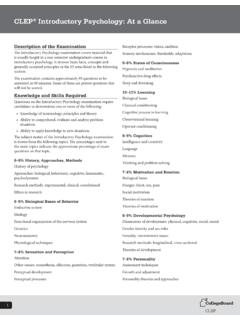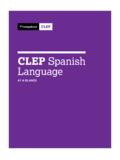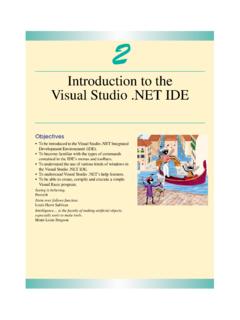Transcription of AP STUDIO ART: 2-DIMENSIONAL DESIGN, 3 …
1 About the Advanced Placement Program (AP )The Advanced Placement Program has enabled millions of students to take college-level courses and earn college credit, advanced placement, or both, while still in high school. AP Exams are given each year in May. Students who earn a qualifying score on an AP Exam are typically eligible to receive college credit and/or placement into advanced courses in college. Every aspect of AP course and exam development is the result of collaboration between AP teachers and college faculty. They work together to develop AP courses and exams, set scoring standards, and score the exams. College faculty review every AP teacher s course STUDIO ART: 2-DIMENSIONAL DESIGN, 3-DIMENSIONAL DESIGN, AND DRAWINGAP STUDIO Art ProgramThe AP Program offers three STUDIO art courses and portfolios: 2-DIMENSIONAL Design, 3-Dimensional Design, and Drawing.
2 The AP STUDIO Art portfolios are designed for students who are seriously interested in the practical experience of art. Students submit portfolios for evaluation at the end of the school year. The three portfolios correspond to the most common college foundation courses. Students may choose to submit any or all of the Drawing, 2-DIMENSIONAL Design, or 3-Dimensional design portfolios. Students create a portfolio of work to demonstrate the artistic skills and ideas they have developed, refined, and applied over the course of the year to produce visual compositions. PREREQUISITE Although there is no prerequisite for AP STUDIO Art, prior experiences in STUDIO art courses that address conceptual, technical, and critical thinking skills can support student success in the AP STUDIO Art STUDIO Art ContentAP STUDIO Art students work with diverse media, styles, subjects, and content.
3 Each of the three portfolios consists of three sections: The Range of Approaches (Breadth) section illustrates a range of ideas and approaches to art making. The Sustained Investigation (Concentration) section shows sustained, deep, and multiperspective investigation of a student-selected topic. The Selected Works (Quality) section represents the student s most successful works with respect to form and content. Students work is informed and guided by observation, research, experimentation, discussion, critical analysis, and reflection, relating individual practices to the art world. Students are asked to document their artistic ideas and practices to demonstrate conceptual and technical development over time. The AP STUDIO Art Program supports students in becoming inventive artistic scholars who contribute to visual culture through art Practices and Habits of MindEach AP STUDIO Art course and portfolio assessment focuses on students developing these practices and habits of mind through work with 2-DIMENSIONAL design, 3-dimensional design, and drawing media and approaches, including the following.
4 Critical analysis Evidence-based decision-making Innovative thinking Articulation of design elements and principles Systematic investigation of formal and conceptual aspects of art making Technical competence with materials and processes to communicate ideas Incorporation of expressive qualities in art making Demonstration of artistic intention Creation of a body of work unified by a visual or conceptual themeAP STUDIO Art StructureAssessment OverviewIn early May, students submit actual works and digital images of works for 2-D Design, 3-D Design, and Drawing Portfolios; for 3-D Design, only digital images are submitted. These works should demonstrate artistic growth and development. Students also submit an artist statement in which they describe ideas investigated and explain how the ideas evolved as they created their body of work.
5 All portfolios are assessed by at least seven highly experienced STUDIO art educators (AP STUDIO Art teachers or college faculty) who apply standard scoring of AssessmentSection I: Selected Works (Quality) | 5 actual works for 2-D and Drawing, 12 digital images for 3-D | 33% of Portfolio Score Demonstrate mastery of design in concept, composition, and executionSection II: Sustained Investigation (Concentration) | 12 digital images | 33% of Portfolio Score Describe an in-depth explanation of a particular design concernSection III: Range of Approaches (Breadth) | 12 digital images for 2-D and Drawing, 16 digital images for 3-D | 33% of Portfolio Score Demonstrate understanding of design issues00558-049 (Updated December 2016) 2016 The College STUDIO Art Sample Portfolio Images2-D DESIGN PORTFOLIO IMAGES3-D DESIGN PORTFOLIO IMAGESDRAWING PORTFOLIO IMAGESE ducators: : : Students.
